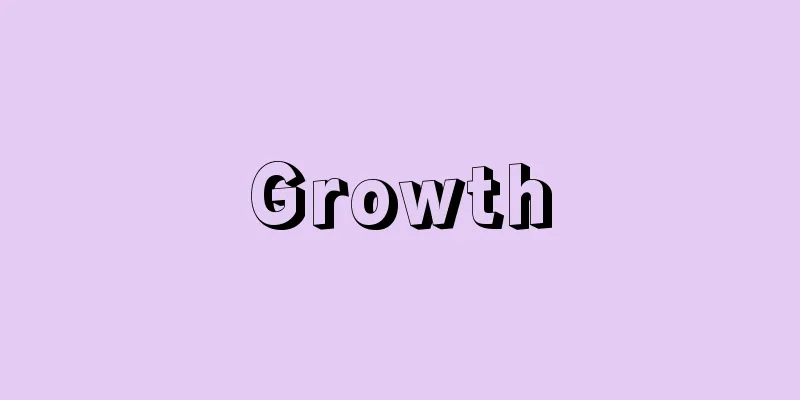Growth

|
In biology, this refers to the irreversible increase in the characteristics of an individual organism during ontogeny (such as length, width, weight, etc.), or of any part of the organism, or of individual organs. Abnormal growth is when an individual grows beyond the limits of the distribution of characteristics within a population, or when a particular part or organ of the body grows out of balance with the others. On the other hand, normal growth is accompanied by the maturation of reproductive organs, and the individual becomes an adult with an independent nutritional life. The growth of body parts and organs depends on the increase in the number of cells in that part, the increase in cell substance (e.g., the elongation growth of plants, the increase in muscle fibers in animal muscle cells), and the increase in intercellular material (e.g., bone and cartilage tissue in animals). In general, it is believed that most cells in animal tissues, except for nerve cells, have the ability to divide throughout their lives. Therefore, the limits of organ growth are thought to be limited by division-inhibiting substances produced by the cells of the organ or tissue themselves (Chiron hypothesis), or determined by hormones that regulate the entire individual (e.g., growth hormone, thyroid hormone, etc.). In plants, only the cells of the cambium, apex, or root tip have the ability to divide, but since there is no restriction on division in plants, there is in principle no limit to growth in perennial plants. The growth of an individual animal is the sum of the growth of each part, so the growth of each part differs from the growth of the other parts. For example, in humans, the brain and nervous tissues grow rapidly in childhood and reach their limit at an early age, while the reproductive organs grow rapidly after puberty and reach their limit. The thymus gland reaches its limit by adolescence and then degenerates. However, when it comes to the growth of the whole human body, it is known that if you plot a growth curve with age on the horizontal axis, it will form a so-called S-shaped curve. This S-shaped curve shows that the body grows slowly at first, then rapidly, and then slowly again approaches its limit. This shows that the ratio between the whole and each part changes with age. Therefore, it can be divided into age-specific body types such as infant type, juvenile type, and adult type. This is true not only for humans but for all animals, but for animals that grow by molting and metamorphosis, the growth curve is not a smooth S-shape but a gradual S-shape. The growth limit of an individual is directly determined by the growth limits of each part, which are controlled by hormones, as mentioned above, but it is also thought to be indirectly determined by the combined effects of various factors, including genetic factors, the quantity and quality of nutrients ingested, various physiological functions, and ecological environmental conditions. [Shigeo Takeuchi] [Reference items] | | |Source: Shogakukan Encyclopedia Nipponica About Encyclopedia Nipponica Information | Legend |
|
生物学用語で、個体発生中の生物個体において、個体全体の諸元(長さ、幅、重量など)、個体の各部分、あるいは個々の器官などの諸元が不可逆的に増加することをいう。 個体が集団内での諸元の分布の限界を超えて成長したり、身体各部、諸器官のうち特定な部分や器官が他とのバランスを失して成長する場合、異常成長という。一方、正常な成長には生殖諸器官の成熟が伴い、こうして個体は独立した栄養生活を営む成体となる。身体各部、諸器官などの成長は、その部分における細胞数の増加、細胞実質の増加(植物の伸長成長、動物の筋肉細胞内の筋繊維の増加など)および細胞間物質(動物の骨や軟骨組織など)の増加などに依存する。一般に動物の組織では、神経細胞を除いてほとんどの細胞が終生分裂する能力をもつと考えられている。したがって、器官などの成長の限界は、その器官や組織の細胞自身がつくりだす分裂抑制物質に制限されたり(ケイロン仮説)、あるいは個体全体を調節しているホルモン(成長ホルモン、甲状腺(せん)ホルモンなど)により決められていると考えられる。 植物では形成層、頂端あるいは根端の細胞のみが分裂能力をもっている。しかし植物ではこの分裂の制限がないため、多年生の植物では原理的には成長の制限はない。 動物個体の成長は、各部分の成長の総和として現れるので、そのようすは各部分の成長のようすと異なっている。たとえば、ヒトでは脳および神経組織は幼年期に著しく成長し早い時期に限界に達するが、生殖器官などは思春期を過ぎて急速に成長し限界に達する。胸腺は少年期までに限界に達し、それ以後はむしろ退化する。ところがヒト全体の成長については、年齢を横軸にとったグラフ、すなわち成長曲線を描くと、いわゆるS字カーブになることが知られている。このS字カーブは、初めは緩やかに成長し、まもなく急激に、その後ふたたび緩やかに限界に近づくことを示している。これは全体と各部分の間の比率が年齢とともに変わることを示している。したがって幼児型、少年型、成人型というように年齢に特有な体型に分けることができる。このことはヒトだけでなくすべての動物についていえるが、脱皮や変態により成長する動物では、その成長曲線は滑らかなS字を描かず段階的なS字になる。 個体全体の成長の限界は、直接には前述のようにホルモンなどに支配される各部分の成長の限界により決められる。しかし、間接的には遺伝的要因、摂取する栄養の量と質、生理的諸機能、生態学的な環境条件などさまざまな要因が複合して働くことにより決められると考えられている。 [竹内重夫] [参照項目] | | |出典 小学館 日本大百科全書(ニッポニカ)日本大百科全書(ニッポニカ)について 情報 | 凡例 |
Recommend
Metal industry
A general term for the manufacturing industry tha...
Implosion type
...The first method is called the gun barrel type...
Charles le Brun
1619‐90 A leading painter and decorator at the Fre...
Romantic Delusion - Renai Moso
A delusion in which a person is strongly convinced...
Aibiki - Aibi
〘 noun 〙 Cooking food over the same fire. Also, th...
Gastric mesentery
…All these parts move well within the abdominal c...
Mycobacterium
…When a person with tuberculosis, especially one ...
Oe - Oe
...Apart from the hearth, housework and farm work...
mechanized infantry combat vehicle
… The basis of armored vehicles is the armored pe...
Tales of Temper - Tales of Habits
Also known as "Kanpekidan," this novel d...
Ranunculus acer (English spelling) Ranunculusacer
…[Michio Tamura]. … *Some of the terminology that...
Syria - Syria (English spelling) Syrian Arab Republic
A republic in Western Asia. Its official name is ...
earthenware
...In Japan, the term "douki" (earthenw...
Agus Salim
1884‐1954 A representative politician and thinker ...
English Teaching Institute - English Teaching Institute
…Born in London, he graduated from the University...









